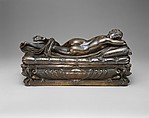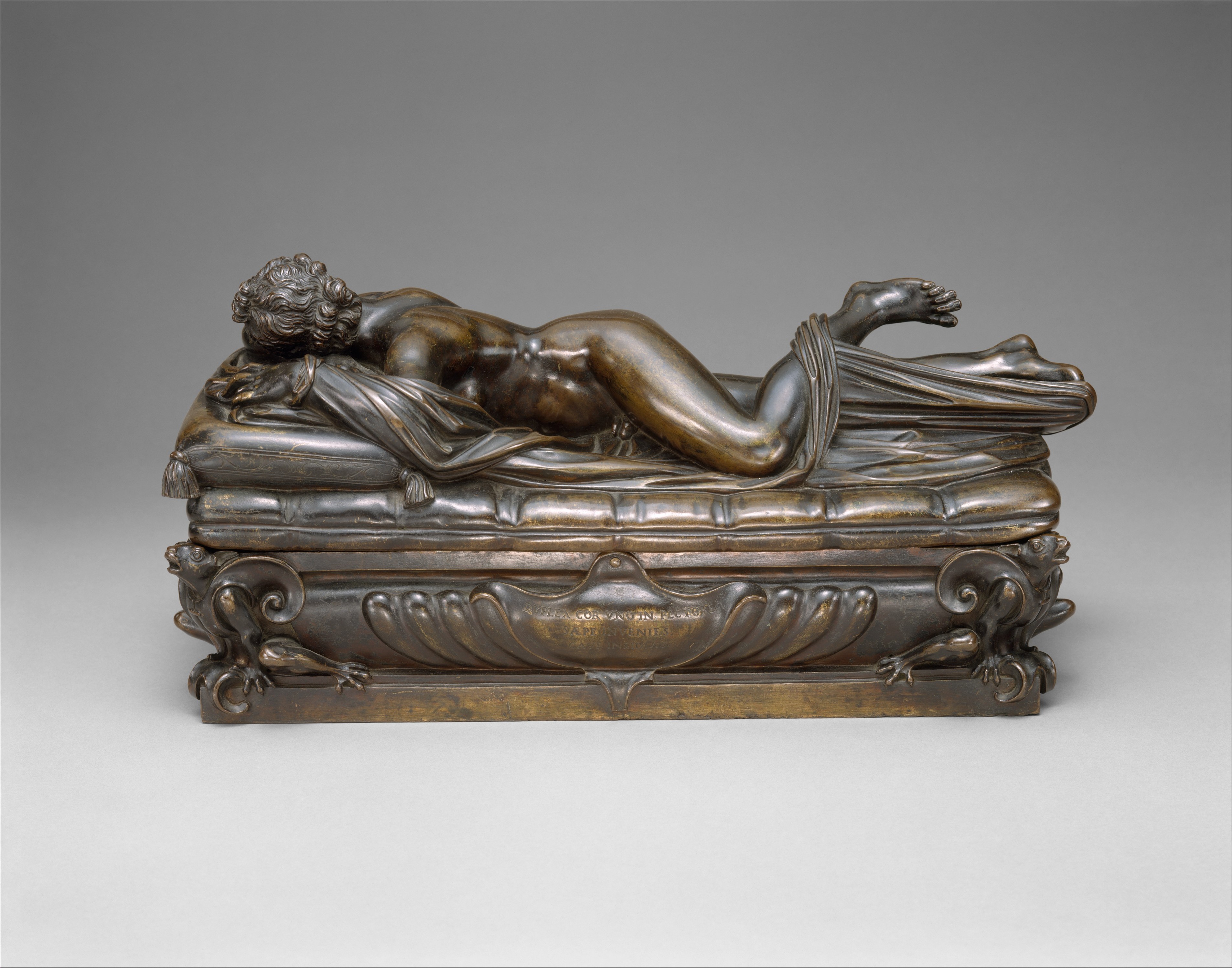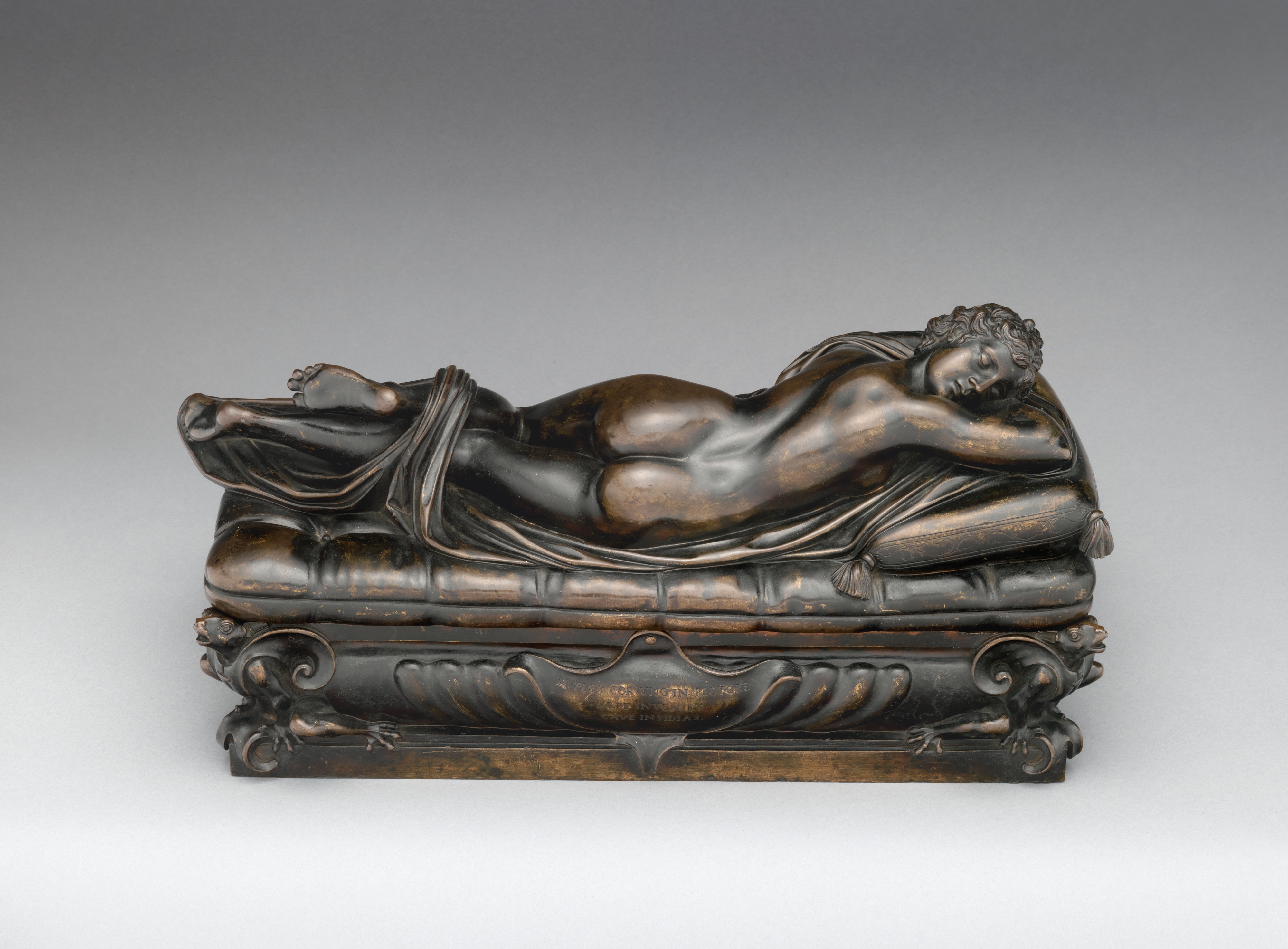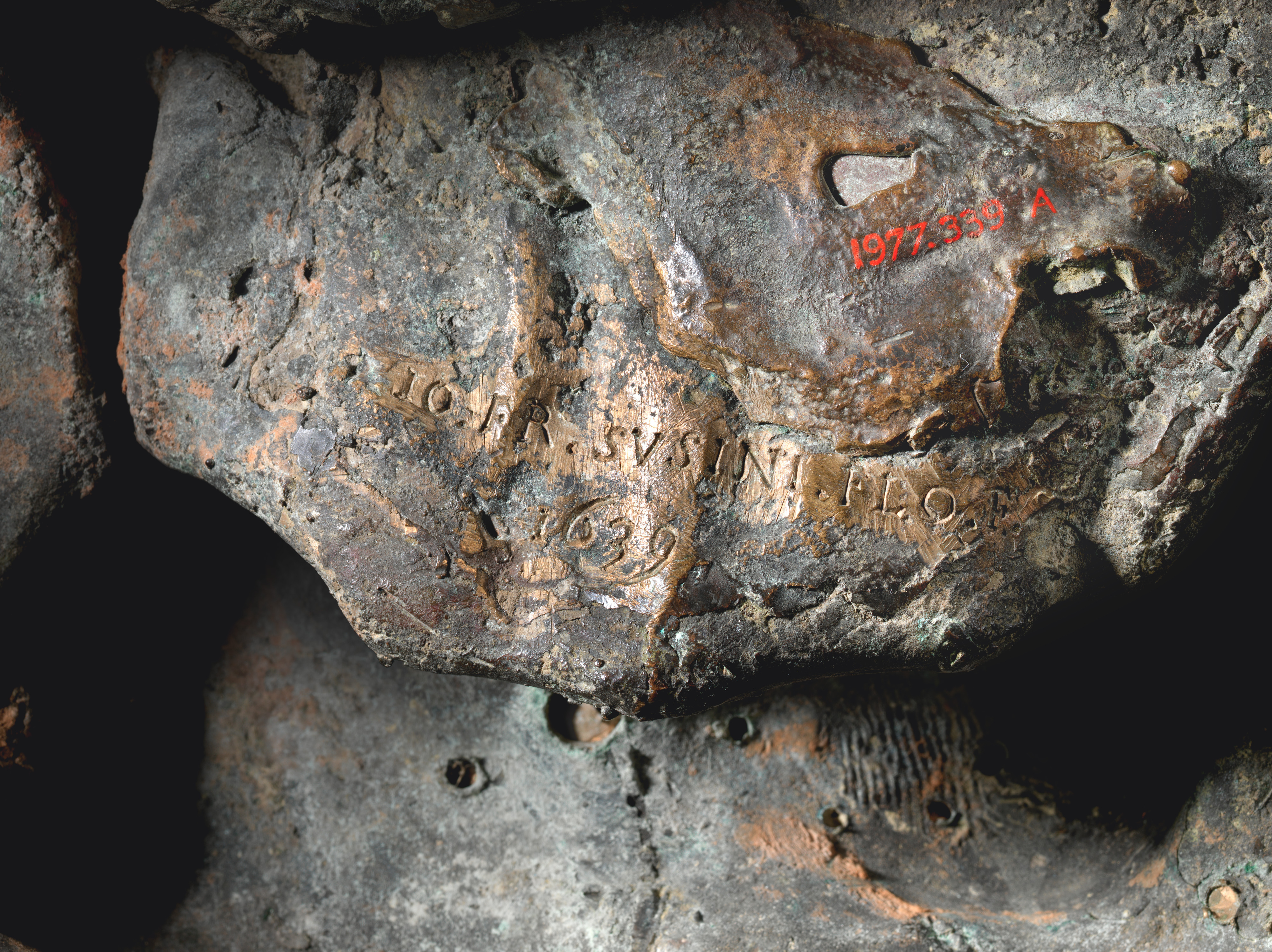Hermaphrodite
Giovanni Francesco Susini Italian
Giovanni Francesco Susini’s artistic personality has taken shape only in recent years with studies of his formal influences, intellectual training, and technical development.[1] An artist of considerable originality, he carved lifesized marble figures and groups[2] and made highly successful statuettes of his own design.[3] In addition, he adapted more large-scale antiquities to bronze statuettes than any sculptor since Antico, a century earlier,[4] and continued his uncle Antonio’s practice of casting statuettes after Giambologna’s models. According to his earliest biographer, Filippo Baldinucci, Susini’s statuettes after antiquities were by far the highest valued of his small bronzes, selling for up to ten times the price of those after Giambologna’s models.[5] Within his oeuvre, the Hermaphrodite stands out as a masterpiece, fusing Susini’s creative and antiquarian impulses.
The nude lies chest down on a tufted mattress, limbs tangled in a sheet and arms cradling the head. Full hips and breast characterize the frontal view; from the opposite side, the raised left hip reveals male organs. A large tasseled pillow supports the stilled upper body. A pacific face suggests sleep but is belied by flexed, restless legs. The right calf is raised, pulling up a loop of the sheet, while the left foot extends off the mattress, toes hooking the sheet’s edge. A host of contradictions, the figure seems both asleep and in motion, covered and exposed, in a private setting and on display, male and female.[6] Further, the most piquant anatomical attribute is visible only when the face is not.
The mattress sits atop an independently cast rectangular base with convex walls suggestive as much of a sarcophagus as a bedframe.[7] Hybrid creatures crouch at each corner, and masks enliven the head and foot of the bed (fig. 137a). Cartouches bearing Latin epigrams on each long side recapitulate and allegorize the figure above, instructing the viewer both to beware of and admire duplicity.
The hermaphrodite was known to the Renaissance from ancient literary and archaeological sources. Ovid’s tale of the libidinous nymph Salmacis joining with Hermaphroditus, the beautiful son of Hermes and Aphrodite, to form this intersexed prototype was well known to Renaissance mythographers, as was Pliny’s account of the biological phenomenon among mortals.[8] The composition was known perhaps as early as 1425, when Ghiberti reported on an ancient sculpture matching its description, recently unearthed in Rome.[9] By then, the idea of the mythical hermaphrodite was already multivalent; it was a creature susceptible to mystical readings, as well as having associations with alchemy and, as in antiquity, entertainment.[10] The humanist Antonio Beccadelli’s controversial book of extravagantly obscene and satiric epigrams, titled The Hermaphrodite, was published in 1425 with a dedication to Cosimo de’ Medici.[11]
Two centuries later, the subject was again a locus of attention, as two lifesized ancient marble sculptures of a sleeping hermaphrodite were unearthed, restored, and installed in the most important princely collections of antiquities in Rome. The first of these was discovered in Rome in 1619 and quickly acquired by Cardinal Scipione Borghese. By early 1620, David Larique had restored the ancient sculpture, and the young Bernini had carved and fitted to it a mattress that in its verisimilitude seems to defy the properties of marble (fig. 137b).[12] The other ancient marble entered the collection of Cardinal Ludovico Ludovisi and was restored between 1621 and 1623 by Ippolito Buzzi in an effort surely prompted by the success of the Borghese restoration.[13] Matthias Winner has suggested that the Ludovisi restoration sought to re-create the rustic Ovidian hermaphrodite, while the Borghese display aimed at the refined “Hermaphroditus nobilis” that Pliny ascribed to Polykles.[14] It is noteworthy that the Polyklian sculpture was made of bronze and is Pliny’s only mention of a sculpted Hermaphroditus.[15] It could well have been appreciated that Susini’s reduction of the sculpture returned the subject to its original material.
The sculptures seem to have been particularly evocative of antiquity and remained a node of taste for some time.[16] In the seventeenth century, they were reproduced in drawings and prints by Rubens, among others.[17] In 1638, the year before Susini dated our small bronze, François Perrier published the first bound collection of prints of the most famous sculptures in Rome, the Segmenta nobilium.[18] Plate 90 shows a reclining hermaphrodite, with a landscape behind, as a combination of the two ancient versions: the figure is disposed on the ground, like the Ludovisi sculpture and Ovidian description, but with a pillow supporting the head, as in the Borghese version and Pliny (fig. 137c).
Susini almost certainly knew the Ludovisi Hermaphrodite, as he made bronze reductions of a number of the cardinal’s antiquities.[19] However, his primary source was the Borghese sculpture. The mattress and pillow of our bronze are derived from Bernini’s celebrated restoration, rather than from the spaded earth, panther hide, and sheet on which the Ludovisi version lies. Susini’s response to Bernini’s early work is also apparent in the composition of his small bronze Abduction of Helen by Paris, which Peggy Fogelman has connected to Bernini’s Rape of Proserpina (1622).20 Susini made at least two trips to Rome, first in the early 1620s, in the years that both marble Hermaphrodites were restored, and again in 1638, the year before our bronze is dated.[21]
The original base for the Borghese Hermaphrodite, described at length in a recorded payment to the woodworker G. B. Soria, was an elaborate walnut chest, decorated with friezes, pilasters, vegetal motifs, grotesques, and putti carved in the round.[22] A matching cover fitted over the sculpture to conceal it, to be opened only for the delectation of select company. The Ludovisi base, shaped like a bed and decorated with masks and scrolls and niches for statuettes, survives and is not dissimilar from the description of the lost Borghese base.[23] Susini’s base resembles neither of the marbles’ wood bases. Bernini’s tour-de-force mattress immediately made the reclining figure’s support a focal point. Susini adapted it, scaling down its fifty tufts to twenty-one, and added an elaborate base comprising over a third of the sculpture’s total height. Figured and inscribed, it vies with the figure above for visual attention.
Already in his earliest known public commission of 1613–15, a pair of bronze holy-water stoups now in the Santissima Annunziata, Susini displayed a flair for scroll ornament.[24] At the corners of the sarcophagus-like base, scrolls wrap around the chests of batlike creatures like a carapace and produce spiraling wings to each side that seem to support the sculpture above. These beasts also have frog- and catlike qualities, while the masks on the short sides of the base suggest other metamorphosing animals—ape and lion, perhaps—all fitting imagery for staging the ambiguous figure. The corner elements are akin to the fantastical creatures that were regularly conceived in the Giambologna workshop, such as a set of monstrous fountain figures,[25] or the “Diavolino” flag holder for Palazzo Vecchietti of 1579, now in the Museo Bardini, Florence. In both cases, as with Susini’s creations, the creatures are essentially subservient to the surrounding architecture. The grotesque fountain figures in Piazza Santissima Annunziata, cast by Pietro Tacca in 1633, and whose ornament parallels work by Bernardo Buontalenti,[26] and Raffaele Curradi’s grotesque figures (ca. 1634) that flank the portal of Palazzo Fenzi-Marucelli offer other points of comparison. Open-mouthed, the latter seem to strain to hold up the architrave.[27]
For the pillow, Susini turned to the Sleeping Venus, a model from Giambologna’s early statuette production that Susini inherited through his uncle and best known today through the documented 1587 version with a satyr in Dresden.[28] Our Hermaphrodite’s pillow is overstuffed, tasseled at each corner, with symmetrical, curling vine motifs incised on the side panels, the same as those that support the Venus’s legs and shoulders and bearing no resemblance to the simple pillow that Bernini conceived for the Borghese marble.
Though their source has yet to be identified, the inscriptions on the base situate the sculpture in the highest echelon of literary culture in early seventeenth-century Rome. The epigram was a popular and versatile poetic form in the Renaissance, when it became closely allied with descriptions of artworks, following classical precedent. Martial’s collections of epigrams in particular, some of which describe paintings and sculptures, inspired writer-collectors in these years.[29] Epigram 174 from his Apophoreta, in fact, treats a sculpted marble Hermaphroditus: “Hermaphroditus marmoreus / He entered the fountain a male. He came out both sexes. One part of him is his father’s; the rest he has is his mother’s.”[30] Throughout the sixteenth century, the association between epigram and epigraph was close; by the early seventeenth century, the Pasquino had become a bulletin board of Latin and vernacular moralizing and political poetry. The taste for epigrams was particularly pronounced in the decades around 1600, with the publication of Giambattista Marino’s Galleria in 1620 marking an apogee in the connection between pictura and poesis as they were cultivated in the epigrammic tradition.[31]
At least two of Bernini’s sculptures in the Borghese collection, Apollo and Daphne and The Rape of Prosperina, had bases inscribed with epigrams composed by Maffeo Barberini, perhaps in the same years as Susini’s first visit to Rome.[32] Barberini’s poetry was well regarded even before he became Pope Urban VIII.[33] Susini’s base owes much to these installations, and it should not be discounted that even though his bronze sarcophagus does not reflect the base for the Borghese Hermaphrodite, Barberini or someone in his literary circle may have authored the inscription.[34] That on the Proserpina is a reduced version of a double distich recorded in Barberini’s own hand in a manuscript now in the Vatican archives.[35] Susini’s inscriptions take this same poetic form.
Susini’s Hermaphrodite survives in at least four versions.[36] The Met’s cast is the most important, not least because of the elaborate base, a unicum, which within the realm of small-scale sculpture has no precedent in works by Giambologna or his followers. It is the only signed version and stands out for the exceptional amount of work after casting, which gave it a high and varied finish. Susini employed an unusually large number of screw plugs (fig. 137d) and polygonal patches to repair the cast and used an unorthodox method for the base, modeled and cast in two j-shaped sections and then fused together.[37]
The ancient Hermaphrodite continued to be reproduced as a bronze statuette in the later seventeenth and eighteenth centuries. A version by François Duquesnoy was paired with a reclining Venus in François Girardon’s collection of sculpture, which was famously documented in a series of engravings in the early 1700s.[38] The idea of such a pairing existed as early as 1638; the Hermaphrodite was similarly displayed near a reclining Cleopatra in Perrier’s Segmenta nobilium.[39] Susini’s composition is to be distinguished from another model, exemplified by bronzes in Vienna and Stockholm, that is slightly smaller than Susini’s version and exhibits more pat surfaces.[40] Its composition follows the restored Borghese ensemble much more closely, to the point of replicating the number of mattress tufts and the location of creases in the pillow. They are reductions from the eighteenth-century workshop of Giacomo and Giovanni Zoffoli and perhaps that of Francesco Righetti, leading founders in Rome, both of which listed the Hermaphrodite in their sales catalogues.[41] The cast in Stockholm bears a Zoffoli signature on the mattress.
-PJB
Footnotes
(For key to shortened references see bibliography in Allen, Italian Renaissance and Baroque Bronzes in The Metropolitan Museum of Art. NY: The Metropolitan Museum of Art, 2022.)
1. Lombardi 1979; Anthea Brook in Florence 1986, vol. 3, pp. 166–67; Brook 2003, pp. 52–56; Cole 2007; Stone 2010; D. Smith 2011. Susini is referred to almost exclusively as “Francesco” in seventeenth-century texts (e.g., Baldinucci 1845–47 [1680s], Bocchi and Cinelli 1677) and archival documents (see Lombardi 1979, appendix), while most of his signed sculptures indicate both given names (e.g., IO. FR. SVSINI), and modern scholars often use Gianfrancesco or Giovan Francesco.
2. See Brook 2003; Lombardi 1979, pp. 766–72.
3. For example, The Abduction of Helen by Paris (Getty, 90.SB.32), Venus Chastening Cupid (cat. 139), David with the Head of Goliath (Princely Collections of Liechtenstein, SK565).
4. For example, The Ludovisi Mars (Ashmolean, WA1953.110), the Dying Gladiator and Porcellino (both Bargello).
5. Baldinucci 1845–47, vol. 4, p. 118.
6. Warwick 2004, esp. p. 364, addresses some of the dialogic possibilities of the subject.
7. C. Avery 1982, p. 429.
8. Metamorphoses IV:285–389; Silberman 1988. Pliny 1938–63, vol. 2, pp. 528–29 (VII:III.34).
9. Schlosser 1912, vol. 1, pp. 61–62. The lengthy description leaves little doubt that the sculpture was of this type, but the marble itself cannot be identified with a surviving example. For the much disputed dating in Ghiberti’s account, see Bober and Rubinstein 1986, p. 98.
10. Wind 1958, pp. 164–65. See DeVun 2008 for the hermaphrodite in relation to medieval alchemy. Pliny describes hermaphrodites in his day “considered . . . now as entertainments” (Pliny 1938–63, vol. 2, p. 529 [VII:III.34]).
11. Beccadelli 2010.
12. Matthias Winner in Coliva and Schütze 1998, p. 130; Kalveram 1995, pp. 119–22, 231–33; Coliva 2002, p. 134. See Haskell and Penny 1981, pp. 234–35, for early praise of the mattress. 13. Haskell and Penny 1981, p. 235.
14. Coliva and Schütze 1998, p. 131.
15. Pliny 1938–63, vol. 9, pp. 186–87 (XXXIV:XIX.80). However, he does not describe the sculpture, and there are other ancient compositions that include the hermaphrodite; see Ajootian 1999.
16. Krems 2002, p. 141.
17. See, e.g., MMA, 1972.118.286; British Museum, 1946,0713.1005.
18. Perrier 1638; see also Laveissière 2011.
19. For example, the aforementioned Ludovisi Mars (see note 4); Penny 1992, vol. 1, pp. 137–38.
20. Signed and dated examples of Susini’s statuette are in Dresden (1626) and at the Getty (1627); Fogelman et al. 2002, p. 197.
21. Brook in Florence 1986, vol. 3, pp. 166–67.
22. Coliva 2002, pp. 136–38, doc. 9.
23. Montagu 1989, p. 161; it was brought to Florence in 1669 and is now in the Uffizi.
24. Some of the organic forms of the stoups, in turn, draw directly on the ornamental vocabulary of Giambologna from the late 1560s; Freddolini 2005, p. 819.
25. Now in the Bargello, Staatliche Museen zu Berlin, and on loan to the V&A; C. Avery and Radcliffe 1978, p. 201.
26. Brook in Florence 1986, vol. 2, p. 447, cat. 4.29.
27. Bigazzi and Ciuffoletti 2002, pp. 116–17; also illustrated in Eiche 2000, p. 126.
28. Baldinucci 1845–47, vol. 4, p. 118; Ebert-Schifferer 2007, p. 301, with further bibliography in n. 1.
29. See Sullivan 1991, esp. pp. 262–70.
30. “Hermaphroditus marmoreus / masculus intravit fontis: emersit utrumque: / pars est una patris, cetera matris habet.” Translated in Martial 1996, p. 235.
31. Fumaroli 1995, pp. 61–80.
32. For the Apollo and Daphne, base and inscription still in situ, and that for The Rape of Proserpina, which was documented when it was in the Ludovisi collection, see Ferrari 2004, p. 59.
33. Poemata, a compilation of his poems first published in Paris in 1621, went through many editions in the author’s lifetime; D’Onofrio 1967, p. 36.
34. D’Onofrio 1967, p. 277, suggests that a poem by Maffeo also inspired Bernini’s Saint Lawrence, now in the Uffizi.
35. Ibid., pp. 274–77.
36. Christie’s, Paris, February 25, 2009, lot 626; Bargello, 373 B; Louvre, MV 7778 (see Paris 1999, pp. 79–80). Untraced documented versions include a bronze Hermaphrodite, matching Susini’s in description and size, that Don Lorenzo de’ Medici owned at the time of his death in 1649 (Lombardi 1979, p. 779 n. 85), and a version with Cyril Humphris from at least 1977 to at least 1988, described in relation to The Met’s bronze as “very well cast, the main difference being in the mattress—stippled all over—and the pillow, textured so like linen that it must have been cast from the cloth.” ESDA/OF.
37. R. Stone/TR, February 23, 2011.
38. Now in the Hill collection, New York; see Wengraf 2014, cat. 32.
39. Lombardi 1979, p. 779 n. 85. Another example is illustrated in Castiglioni 1923, p. 45, pl. 87. For the Vienna version, see Planiscig 1924, pp. 169–71. See also Nationalmuseum, Stockholm, NMSk 332.
40. Haskell and Penny 1981, pp. 342–43 for the sales lists, p. 235 for other versions in early collections.
This image cannot be enlarged, viewed at full screen, or downloaded.
This artwork is meant to be viewed from right to left. Scroll left to view more.









